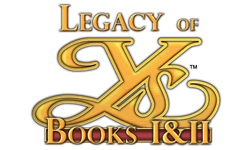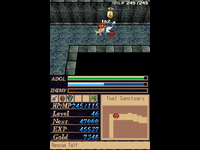|
|

|
PLATFORM
|
DS
|
BATTLE SYSTEM
|

|
INTERACTION
|

|
ORIGINALITY
|

|
STORY
|

|
MUSIC & SOUND
|

|
VISUALS
|

|
CHALLENGE
|
Easy
|
COMPLETION TIME
|
Less than 20 Hours
|
|
OVERALL

|
+ Fast pace keeps the gameplay fun.
+ Solid localization and interface.
- Obtuse actions needed to progress the plot.
- Too much backtracking in Ys I.
|
Click here for scoring definitions
|
|
|
Although it never attained worldwide fame and support similar to its peers, Ancient Ys Vanished Omens came out in Japan right around the same time as Dragon Quest and Final Fantasy. While it is Japan's preeminent action RPG of the era, the runaway success of those two series has made Ys the "other" JRPG series with 80s origins. Legacy of Ys: Books I & II is a 2-in-1 package containing remakes of the earliest two Ys entries. The new interface and presentation are spot-on, and the quick pace of the gameplay has allowed it to age much better than Dragon Quest and Final Fantasy, but it lacks anything so spectacular as to put it above the DS's many other RPG offerings.
Ys I begins as Adol Christin, the young redheaded swordsman, reaches the land of Esteria. There he finds a mysterious woman, a prophecy, and an inexplicable compulsion to do whatever perfect strangers tell him to do. The story may be weak, but it packs a few surprises, the lore-filled world is interesting, and Atlus USA's new localization manages to keep the dialogue compelling even though not much is going on. This is definitely a case where a solid translation makes up for a subpar plot. Upon finishing Ys I, the player will discover that Ys II picks up immediately where it left off. Ys I is not much more than a lengthy introduction to Ys II, which builds on the first's gameplay and story so handsomely that Ys I hardly seems like a complete game by comparison. The plot in Ys II follows Adol as he continues to fight evil and villainy, and although the story sequences are marginally more touching and barely more interesting, they are still propped up by the well-executed script.
Honestly, though, who plays a twenty year old video game for the plot? The unique battle system is the focus of the gameplay. Ys's battles play out in real time; as Adol runs around the world, enemies regularly spawn all around and aggressively attempt to ram themselves into him. An odd quirk comes in the lack of attacks, conventionally speaking. Adol deals damage by colliding with foes, and foes, likewise, deal damage by colliding into Adol. The trick is to bash into enemies from the side, back, or slightly off-center so that the baddie takes damage and Adol does not. Human cannonball Adol directly into a monster's gut, and expect to lose some life. The stylus controls Adol's movement, and the implementation is responsive and precise enough that it could be the best use of stylus controls in any RPG on the DS.
For those who despise tradition or hate things that are different, an alternate control scheme is available to turn Ys's gameplay into something more Zelda-like. Toggling off the stylus controls allows the player to move Adol around with the d-pad. This also disables the "sprint into enemies for the win" mechanic, giving the player an attack button and forcing him to manually swing Adol's sword for damage. Really, both control options work just fine, and it is great having two very different ways to play the game. When Adol is much stronger than the enemies around him, it works best to use the stylus to careen across the landscape, automatically slicing and dicing anything foolish enough to cross his path. Against foes who deal out massive damage, it might work best to abandon the stylus in order to precisely time Adol's sword swings. For combat in between those extremes, the player can stick to whichever style he prefers.
 Fireball for the win!
Fireball for the win!
|
|
Combat makes one final twist for the better in Ys II with the introduction of magic. Adol gains various magical spells in the sequel, most notably the ability to shoot large fireballs across the screen. Fireballs do more damage than sword attacks, and, naturally, can annihilate foes well before they get into headbutting range. Another magic spell causes monsters to ignore Adol's presence entirely, thereby allowing him to run harmlessly across the world when the need arises. Considering how simple the battle system is, the way it changes focus over the course of the two games keeps it from getting stale. More importantly, the wicked-fast pace of Ys is nearly unreplicated in current generation RPGs. Monsters move quickly, and reappear the instant the screen moves back over their spawning points. This frantic speed keeps the player attentive, showing how good developers were back in the day at taking basic gameplay and keeping it interesting and fun for fifteen hours. Complementing this is the low amount of experience needed to level up. Grinding in an RPG usually means thirty minutes or more of monster smacking, but in Ys a new level can be gained in two or three minutes. If the enemies are too tough, it often only takes gaining a couple of levels to make them manageable, so the rapid pace is never broken.
While the battle system still holds up well by today's standards, some other aspects of the gameplay do not. Like most RPGs from the distant past, the objectives are unclear, and in many places the player is expected to blindly use every item on every wall to find the next plot point. Only players with the patience and time of an 80s gamer will complete this game without resorting to a walkthrough, and those who value their sanity will need to utilize a FAQ on several occasions. More irritating is the reliance on backtracking. To extend the length, Ys I forces Adol to run back through previously visited areas several times, and it is downright obnoxious. Combined with the vague plot directions, it makes for some moments where the player is expected to waste time scouring the entire world to figure out what the heck to do next. Ys II is significantly more reasonable in this regard, keeping the game time up by providing a larger world rather than sending Adol back and forth across a tiny one, and supplying a warp spell so that backtracking is a breeze.
 You and I collide.
You and I collide.
|
|
The overall presentation is good for the remake. The backgrounds are rendered in 3D, but the perspective is fixed and nearly vertical — similar to Dragon Quest IV, V, and Pokémon — so the visuals are pleasing to the eye without much DS jaggedness. Characters and monsters are represented by 2D sprites that blend into the 3D background well, but are not particularly detailed. Major plot points are gifted with bright, anime-style cutscenes. Sadly, the DS has its typical impact on a well-loved score: the oft-touted Ys music sounds average coming from the tinny DS sound chip. As previously mentioned, the interface and translation are both great. Like an old JRPG, characters speak in short bursts, rarely divulging more than two sentences at a time, but unlike an old JRPG, everything they say is coherent and clear. It feels old-school while allowing NPCs to emote effectively. The Atlus USA writers showcase their quirky humor in Ys II when Adol can converse with enemies. The extraneous monster dialogue is amusing.
Legacy of Ys provides a peek at what might have been for JRPGs had Dragon Quest and Final Fantasy not run away with the genre. Ironically, the gameplay in Ys has aged better than these ultimately more successful series originals. It is fun, fast, and only dull when backtracking across the world; the sole frustrations come in guessing what to do next, never from unbalanced difficulty. Quick level ups with a large impact on damage dealt and received keep both games from being hard, and Adol's health automatically regenerates in most areas of the world. The remake comes out on the perfect system for its gameplay. The simple mechanics and ability to save anywhere, anytime make it an excellent game to play on the road, in bed, or any other time a game must be played in short bursts. Still, when compared to other RPGs available on the DS, it rates right about on par since it does nothing extremely well nor obstructively poorly; the best that can be said about Ys is that it feels unique even today, and the worst that can be said is that its uniqueness does not stand out as being noticeably above or below average. It is enjoyable enough to be worth the money, but hard to outright recommend due to some of its old-school idiosyncrasies.
Review Archives
|









